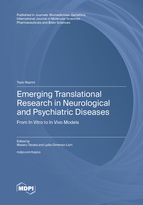Topic Menu
► Topic MenuTopic Editors


Emerging Translational Research in Neurological and Psychiatric Diseases: From In Vitro to In Vivo Models

A printed edition is available here.
Topic Information
Dear Colleagues,
Translational research is one of the most essential but challenging areas of laboratory sciences when it comes to understanding the underlying pathomechanisms of, to search new biomarkers of, as well as to develop novel therapeutics for, neurological and psychiatric disorders. In vivo and in vitro disease models have been remarkably contributing to cast a light on the complex polygenic, multifactorial, and heterogenous disease mechanisms. Furthermore, emerging animal models are revealing the intriguing interaction of sex/gender and ageing with the pathogenesis of neuropsychiatric diseases.
The diseases applicable to translational research range from Alzheimer’s disease, Parkinson’s disease, multiple sclerosis, Huntington’s disease and amyotrophic lateral sclerosis, infectious prion disease, sequelae to stroke and HIV infection, to psychiatric disorders, including depressive disorder, bipolar disorder, substance abuse disorder, post-traumatic stress disorder, anxiety disorder, schizophrenia, somatic symptom disorder, autism spectrum disorder, hyperactive attention deficit disorder and rare diseases.
This Special Issue highlights the most recent development of translational research in neurologic and psychiatric diseases. We cordially invite authors to contribute original research articles focusing on, but not limited to, the following:
- Etiology, pathogenesis, and progression mechanism;
- Early diagnosis including biomarker, bio-imaging, biosensors;
- Biomaterial biomedical research;
- Prophylactic, disease-modifying, and therapeutic strategies, novel targets;
- Novel drug discovery and development, naturally driven biomedicines, natural bioactive molecules, vaccines;
- Novel targets in various therapeutic areas: cardiovascular, vascular, hematology, oncology, neurology, orthopedics, dermatology, ophthalmology, and other peripheral systems;
- Biopharmaceutical biomedicine, biologics, biosimilars, nanobiotechnology, nanosimilars, nanobiosimilars;
- nanoscaffold implants (synthetic vascular graft), biosensors;
- bioimaging, gene therapy, vaccine, cell therapy, and tissue engineering.
Review articles including expert opinions, systematic analysis, metanalysis, and other statistical and analytical methods are also welcome.
Dr. Masaru Tanaka
Prof. Dr. Lydia Giménez-Llort
Topic Editors
Keywords
- Alzheimer’s disease
- Parkinson’s disease
- multiple sclerosis
- stroke
- depressive disorder
- bipolar disorder
- post-traumatic stress disorder
- anxiety disorder
- schizophrenia
- somatic symptom disorder
- autism spectrum disorder
- hyperactive attention deficit disorder
- rare diseases
Participating Journals
| Journal Name | Impact Factor | CiteScore | Launched Year | First Decision (median) | APC |
|---|---|---|---|---|---|

Biomedicines
|
4.7 | 3.7 | 2013 | 15.4 Days | CHF 2600 |

Geriatrics
|
2.3 | 2.7 | 2016 | 22.4 Days | CHF 1800 |

International Journal of Molecular Sciences
|
5.6 | 7.8 | 2000 | 16.3 Days | CHF 2900 |

Pharmaceuticals
|
4.6 | 4.7 | 2004 | 14.6 Days | CHF 2900 |

Brain Sciences
|
3.3 | 3.9 | 2011 | 15.6 Days | CHF 2200 |

MDPI Topics is cooperating with Preprints.org and has built a direct connection between MDPI journals and Preprints.org. Authors are encouraged to enjoy the benefits by posting a preprint at Preprints.org prior to publication:
- Immediately share your ideas ahead of publication and establish your research priority;
- Protect your idea from being stolen with this time-stamped preprint article;
- Enhance the exposure and impact of your research;
- Receive feedback from your peers in advance;
- Have it indexed in Web of Science (Preprint Citation Index), Google Scholar, Crossref, SHARE, PrePubMed, Scilit and Europe PMC.

